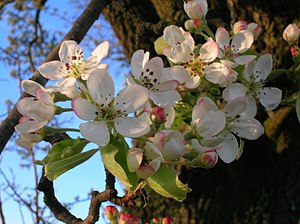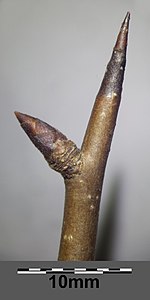Wild pear
| Wild pear | ||||||||||||
|---|---|---|---|---|---|---|---|---|---|---|---|---|

Blossom of the wild pear |
||||||||||||
| Systematics | ||||||||||||
|
||||||||||||
| Scientific name | ||||||||||||
| Pyrus pyraster | ||||||||||||
| ( L. ) You Roi |
The wild pear ( Pyrus pyraster ), also wood pear mentioned, is a kind from the kind of pear ( Pyrus ), leading to the pome fruit crops (Pyrinae) in the family of the rose family belongs (Rosaceae).
description
The wild pear is a deciduous tree . It reaches a height of 8 to 20 meters, but also occurs as a medium-sized shrub with a height of two to four meters.
The wild pear has a small, scaly gray bark. In contrast to the cultivated forms, the branches are covered with thorns. The plants can reach an age of 100 to 150 years.
The wild pear blooms from April to May. Its fruits have stone cell nests that cause lignification. The cultivated pear ( Pyrus communis ) has been bred from the wild pear , with hundreds of cultivated varieties of tastier and softer fruits (see list of pear varieties ).
The wild pear is a tree of the nutrient-rich alluvial forest and the forests of warm low mountain ranges. In Central Europe, it is mainly found in the warmer regions such as Central and Southern Germany. The culture form occurs almost everywhere.
The number of chromosomes is 2n = 34.
Occurrence, distribution
The distribution area of the wild pear extends from Western Europe to the Caucasus. It does not occur in Northern Europe because it needs warmth. Under forest conditions, it is often displaced to very dry locations by more competitive tree species and therefore occurs most frequently on the dry border of the forest, for example on slopes rich in bases and flat, south or west facing slopes in the low mountain range. But it can also be found naturally in alluvial forests on the Rhine and Elbe. In Central Europe it is a character species of the Querco-Ulmetum from the Alno-Ulmion association, but also occurs in societies of the Carpinion, Berberidion, Erico-Pinion or the Quercetalia pubescentis associations.
The wild pear, on the other hand, can be planted in most locations where it receives enough light. The only difference is that the soil should not be acidic or wet, and frosty areas are unsuitable. So far economically almost insignificant, there is hardly any experience with their treatment or extraction in mixed stands. This may change due to the increased efforts of forestry in the recent past. The wild pear is currently on the red list of endangered species in various federal states.
On behalf of the German Federal Agency for Agriculture and Food (BLE) , the occurrence of ten rare native tree species in German forests was determined as part of the project recording and documenting genetic resources of rare tree species in Germany from 2010 to 2013 . 14,000 specimens of the wild pear were recorded in Germany .
Use, ecological benefit
The wood of the wild pear is heavy, not very elastic, but durable and can also be polished. It can be used for carpentry, turning and carving work. In the past it was used as an imitation of ebony (see also Swiss pear tree ).
Wild pear wood is very popular, but due to its rarity it is hardly available on the wood market. It's easy to edit. The few wild pear trunks often go to furniture carpentry at enthusiast prices and are used there as a substitute for walnut (stained for ebony) or valuable veneer and inlay work. The wood of the wild pear has a pale reddish to light reddish brown color, but can also become darker in the so-called false core and is usually steamed before further use . It can also be used for construction purposes - in some old wooden houses, centuries-old pear wood beams still support the heavy ceilings.
In addition to this use of wood, the wild pear - like all wild fruit species - has a high ecological benefit, especially because of its flowers, which are important for many insects, and the fruits that are important for the animal world (e.g. dormice, marten, badger, hedgehog).
Medicine, Mythology and Customs
A tea that is effective in treating kidney pelvic infections can be made from pear tree blossoms. The young, still closed flower buds make a tasty side salad. Pear juice serves as a cure for general detoxification of the body. In times of need three pounds of cooking oil were obtained from 25 pounds of pear seeds. In addition, the pear tree was also said to have the ability to effectively relieve people of pain and diseases, especially toothache, gout and consumption.
In mythology , the pear tree is often viewed as the place of dragons , witches and demons .
The pear tree and apple tree are “the couple” in the orchard: if the apple tree has been associated with the feminine since ancient times, the pear tree symbolized the masculine. An old farmer's rule says: "If you want a cow calf, bury the afterbirth of a cow under an apple tree, next time you want a bull calf, bury the afterbirth under a pear tree." For an oracle of love, young men should go under an apple tree, girls under a pear tree. In the rough nights between Christmas and New Year, they got information about the coming year. B. At midnight girls sneaked under a pear tree, slipped their wooden shoes and threw them onto the tree. If they get stuck in the branches, a beautiful youth would get stuck on the girl next year.
Wild pear trees as natural monuments
literature
- Jochen Kleinschmit (compilation) et al .: Die Wildbirne, Pyrus pyraster (L.) Burgsd. Conference on the Tree of the Year on March 17th and 18th, 1998 in Göttingen. Writings from the Forest Faculty of the University of Göttingen and the Lower Saxony Forest Research Institute, Volume 125. Sauerländer, Frankfurt am Main 1998, ISBN 3-7939-5125-1 .
- Christian Wild (Red.) Et al .: Contributions to the wild pear . Reports from the Bavarian State Institute for Forests and Forestry, No. 23. LWF, Freising 1999.
Individual evidence
- ↑ a b Erich Oberdorfer : Plant-sociological excursion flora for Germany and neighboring areas . 8th edition. Verlag Eugen Ulmer, Stuttgart 2001, ISBN 3-8001-3131-5 . Page 502.
- ^ Federal Institute for Food and Agriculture (BLE) . Retrieved April 23, 2015.
Web links
- Wild pear. In: FloraWeb.de.
- Profile and distribution map for Bavaria . In: Botanical Information Hub of Bavaria .
- Pyrus pyraster aggr. In: Info Flora , the national data and information center for Swiss flora . Retrieved November 5, 2015.
- Thomas Meyer: Data sheet with identification key and photos at Flora-de: Flora von Deutschland (old name of the website: Flowers in Swabia )
- Compendium on the wild pear of the Bavarian State Institute for Forests and Forestry with a detailed bibliography



